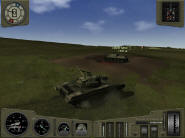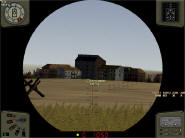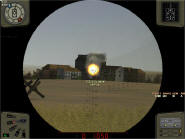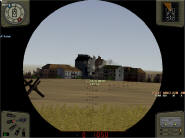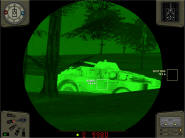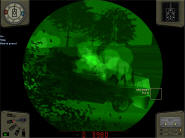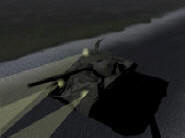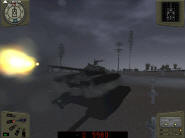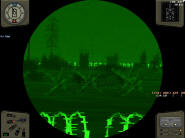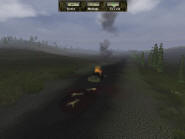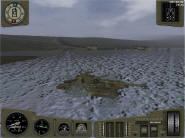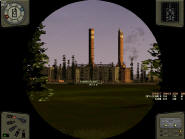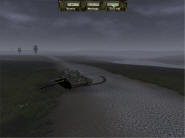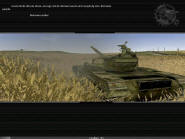T-72: Balkans on Fire!
Review 4/26/06
By Neal
In the short history of computer tank simulations we've had basically two types: WWII and modern era tanksims. Lately we haven't had any new serious sims to speak of, which makes T-72: Balkans of Fire! (published by Battlefront, Developer: IDDK/Crazy House) a double blessing. It's strives to be a simulation and it heralds a new front: Eastern Europe.
T-72 takes place during the Yugoslavian civil wars from 1991 to 1995.You, the player, are a Russian volunteer tank commander, supplied with Russian built tanks; the T-34/85,T-55A and the T-72B.Your opponents include the M50 "Super Sherman", Leopard 1A4, SU-100 assault gun, other T-55s and Russian armor, the BRDM-2 APC, and just for fun, the Mi-8 assault Helicopter. During game play I had to navigate and fight in forests, river crossings, hills and valleys plus urban areas. The game campaign consists of 18 linked missions and 5 single missions. the two training missions are detailed and informative with text instructions that tell you what to do and which keys do it. Since this review is coming well after the game has been released (and doing well, I might add), I would like to point out the excellent support Battlefront has given this game. At the time of this review there is a significant patch and two mission packs which add 21 missions and two new desert maps. The game supports cooperative and competitive LAN battles but no Internet action, nor a dynamic mission generator but it does have a nifty mission editor.
You can play as the driver, gunner or commander. The AI crew handles whatever station you are not managing. In any role you can pass on orders and instructions to the other two AI crew. For example, as the gunner you can tell the driver to go to a waypoint, instruct the commander to scan for targets. If he finds one, he will tell you. You can order the driver to stop and face the target or find a hull-down position. There are times when switching between stations can be disruptive--the AI driver always takes his foot off the throttle when I switch from driver to gunner, requiring a quick jab at the "5" key to get him going again. The easiest strategy is to play one role and stick to it through most of the mission.
T-72 has about as many config and realism options as I've ever seen in any sim. There are numerous settings within the game and an external game config application to tweak realism, physics, sounds and character speech, textures, barrel wear, cheats, and more. One problem I had with the joystick, I was unable to get the "invert joystick" to work, so pushing the stick forward raised the gun barrel, and pulling the stick, lowered it. I prefer to tank with a stick but I put it away and used the default keys, which do the trick.
Some keys are worth noting. Switching to the map by pressing F11, this is a toggle action. Pressing another station of view key does nothing, you have to press F11 again to toggle the map off. Switching to external views is pretty similar; you have to press F9 again to get out of the external view. It's a learned behavior.
The career campaign consists of 18 scripted missions with one or more objectives. You begin your career in an old T-34 abandoned by the Croat army, working your way up to the T-72. Some missions are challenging and some are just plain tough. The enemy always starts in the same places but tanks and infantry that are not dug in will patrol and roam freely, causing a surprise or two when you are replaying a mission for the third time thinking you know where everyone will be. AI behavior is competent, their gunnery is worthy of Guderian. They won't hit you with every first shot but give them a clear target and you won't have much time to answer. Enemy armor presents a constant threat but they are not infallible. You have to make the right moves and act fast but once you get familiar with the interface and your tank's capabilities you can fight your way through a mission in a few attempts. There are missions where you have additional forces under your command but they're not much help. I found them useful as decoys. Controlling them is done from the map station and the design is a little flaky--it often took several tries to get them to move and fight.
Starting a mission mirrors real life nicely. You are given an objective, you start the tank engine, apply throttle, release the mountain brake, and shift into first gear. The tanks have five or more gears and their use is determined by the terrain. On paved roads, the tank will take the highway gear and rumble along at speed. Beware, if you try to turn to quickly at high speed, especially on pavement, you will probably throw a track and have your Russian tank commander (TC) swearing at you. He does that a lot.
Crossing fields and rough terrain requires a lower gear, making you accept a lower speed. Drive too fast and the TC will tell you to slow down. When you have to cross streams and fords you will gear down to first and keep the engine revved up or stall the tank. Having so much driving activity is stimulating and the engine physics are really good. Every turn you make drops the rpms. Going uphill will bog the engine, forcing you to shift down. This is a tank that you actually get to drive, not just control. The T-72 battlefield is littered with anti-tank obstacles like barbed wire roll, dragon's teeth, hedgehogs, ditches, and minefields. Run into one and you will damage or disable your tank.
The AI driver will drive to waypoints (they are not shown on the map) but you will still need to give him a hand and make sure he doesn't smack a barn or obstacle. His behavior is little dodgy. The AI driver will start/stop/turn/start and repeat, not really making much headway at times, as if he's following some invisible programmed track. Other times his performance is fine but you can't ever trust him completely.
Of course, if driving was the only feature it would make the game pretty dull. Once you decide to play the role of gunner or TC, you let the AI driver take over and you give him basic commands such as "Go left", "Go right", "Stop", "Find a hull down position", "Face the enemy", etc. This allows you to scan for enemies and work the main gun. I preferred to give instructions from the TC's seat. You can ride along unbuttoned with a wide range of view. When combat begins, you can drop to the TC's view and use the Dual mode to control the gun. Or you can switch to the gunner and work the 125 mm smoothbore cannon.
There are several types of ammo to choose from: armor-piercing, hollow charge, fragmentation, and guided missile. Your fighting prowess is greatly enhanced by selecting the proper round for the job. The fire control enables the laser range finder and the process of getting the tank facing the target, getting the range and the shot off is exhilarating. Once you fire, you don't want to spend a lot of time watching the results; manually load the next round and you may choose to maneuver while it's loading.
Most building and objects are destructible. Trees in forests can be knocked down but recklessly ramming trees can tear up your tank and have your Russian crew swearing at you. It's a thrill to fire at a Sprut and see the trees next to him fall. The game has a visual cue system that puts a small square and label around visible enemies, replicating a sharp-eyed commander. He will call out targets as he sees them, even when you are in the TC's role. It's absolutely vital in this game--so much is going on, managing three stations at once can get you killed. The enemy AI is very clever and will use pits, buildings, and trees for cover. There were times I spotted a camouflaged tank hidden in a grove of lime trees or peeking out from behind a building before the TC called him out.
Enemy infantry can be hazardous to your survival, especially the RPG soldiers. The rest of the ground troops pose little threat to your armored monster. They're not very mobile, nothing like the Battlefield 1942 bots, but they are serviceable as machine gun targets.
Since this is a combat sim, stuff is bound to get broken. T-72 features an extensive and realistic damage modeling set. A small damage indicator informs you what quarter your taking fire from and where your tanking is damaged. According to the 70-page manual, the tanks have their armor thickness incorporated in the program along with numerous systems and parts that can be damaged or knocked out. Any system that is disabled will not be available for the player. I've seen the engine knocked out, treads shot off, coolant discharged, the gunner's lens cracked over. This really angers the AI tank commander--nobody says "Bastards!" like a Russian. When the SUO targeting system is damaged, you have to aim manually. When a member of the tank crew is killed, his station is no longer available (and the rest of the crew usually scrambles out and tries to crawl away). Several times I took a viscous hit and my tank developed a wicked shimmy, making it pretty hard to get going fast in a straight line. When a tread comes off it typically is repaired after an interval. That's great except usually whatever shot the tread off is still after you and you're immobilized. It can get ugly out there.
Night missions give you a chance to use the Russian night vision gear. This is one area the game could use some improvements. Balkans on Fire's night is not very dark, more like a hazy dawn. I found it strange that the grass and low-lying foliage would disappear in the green low light mode. Night vision does not stay active when switching views which is pretty frustrating. The game should have a single night vision switch that stays constant for all stations.
Graphics are a strong point in this sim. The terrain is varied; hilly mountainous regions strewn with rock gorges and rolling open spaces, rolling plains, and moderately dense forests. Unlike Steel Beasts simple two types of buildings (barn and barn with a door), T-72: BOF displays a wide assortment of buildings, houses, storage tanks, towers, and even a cemetery. From the driver's position you can see individual flowers and grass sway with the breeze. The weather is represented in good detail, complete with rain drops on the vision blocks. Another area that shines is the postgame report. You can fly the camera to all the major combatants and the destroyed vehicles have little indicators to show the point of impact. All shots and misses, enemies damaged and destroyed are tallied in a statistic page. These two strong features contrast the rather weak sound suite. For the most part, the sounds are adequate but underwhelming. Getting hit by a tank round should ring your bell.
Since the last serious tanksim you played is likely over three years old, you'd be crazy to pass up T-72. Overall the game feels a little rough around the edges but Tanksim.com isn't afraid of rough edges. T-72: Balkans on Fire delivers what we like: engaging gameplay, varied missions, attention to detail, and combat realism. Sign us up.
© 2006 Tanksim.com
Rating:
80
Realism Historical Accuracy Graphics Sound/
MusicGame play Repeat Play Stability
/BugsInter-face Multi- play Mission Editor 18/20 8/10 7/10 5/10 17/20 7/10 4/5 4/5 2/5 5/5 Bonus: Extensive damage modeling, postgame reporting +3 System Requirements
Minimum:
1 GHz Athlon or Pentium III CPU; 256 Mb RAM; DirectX 9.0 Compatible Video Card (ex: GeForce 2/4 MX or Radeon 7500); DirectX 9.0 Compatible Sound Card; 2 Gigabyte free space on Hard drive; DirectX 9.0c; Windows XP or Windows 2000 Operating System
Recomended:
2.8 GHz or Higher Athlon XP or Pentium IV CPU; 512 Mb RAM ; DirectX 9.0 Compatible Video Card (ex: GeForce FX5600 or Radeon 9600XT) ; Sound Card with DirectX 9.0 Hardware Support (ex: SB Audigy 5.1); 2 Gigabyte free space on Hard drive; DirectX 9.0c; Windows XP SP1
To order a copy, visit Battlefront
All content is © 2000-2009 by TankSim.com; All rights reserved by Tanksim & TankSim.com
TankSim.com is a subsidiary of the World Sim Network. Staff info: About TankSim.com
For problems or questions regarding this web contact TankSim.com e-mail. Legal Notice | Privacy Policy
